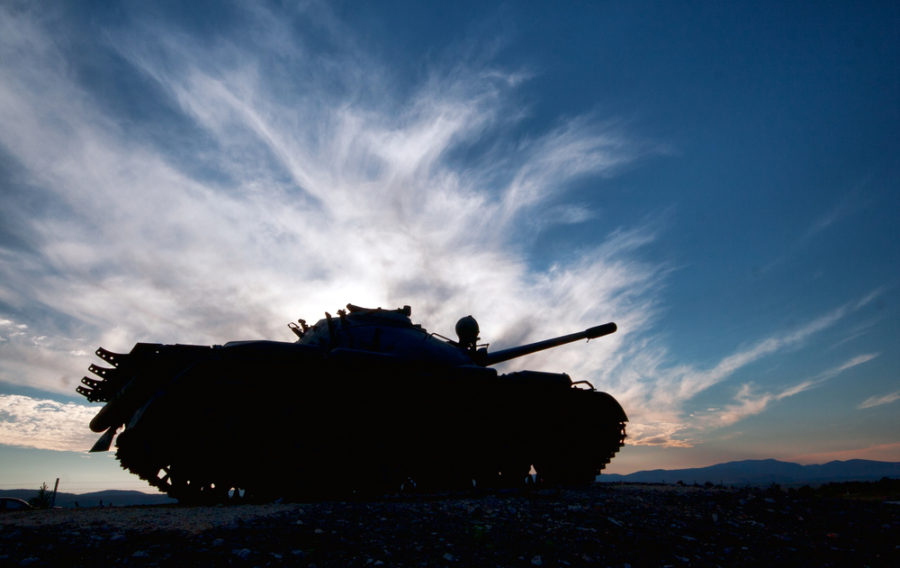
100 years of the Tank: evolving from heavy artillery to invisibility
Thursday 15th September 2016, will see the tank mark a centenary in action, we take a look back at this crucial piece of equipment, the technology being developed and what the future might hold.

The face of modern warfare was changed forever during the British attack on the German 28th Reserve Infantry Regiment at Flers–Courcelette with 32 tanks taking to the battlefield. In an effort to break the stalemate of the Somme, tanks were brought into use for the first time and revealed the potentially decisive role of tanks on the modern battlefield.
With more than 60,000 tanks in operation worldwide, together with other armoured vehicles, they continue to play a key part in modern armies, from peacekeeping to disaster relief and warfare, and the technology has continued to evolve.
However, as the face of modern warfare changes, experts from the Ministry of Defence’s Defence Science and Technology Laboratory (Dstl) have been looking at what the future holds not just for tanks but for all armoured fighting vehicles (AFVs). With appropriate timing, this year’s Defence Vehicle Display, was hosted last week at Millbrook Proving Ground, Bedfordshire, where over 200 exhibitors showcased their new technology.
This years’ theme at DVD was development, modernisation and sustainment of land equipment. The 2016 event displayed the equipment and technology that will support troops in the future and Defence Online were lucky enough to be invited to see what the defence contractors had to offer, with displays ranging from specialist vehicles to all the equipment and services necessary to support land-based military operations.

credit: lcocl2/shutterstock.com
Keeping up with the dramatic advances in technology, has meant a global trend towards platform capability enhancement through sub-systems upgrades rather than the acquisition of new vehicles.
Improvements mainly centre around the areas of lethality and protection, including more effective munitions, enhanced Fire Control systems, increased main armament calibres and Gun-Launched Anti-Tank Guided Missiles. With protection enhancements focussed on signature reduction technologies, base armour protection, add-on active armour and Defensive Aid Suites. Tactical communications improvements will focus on data capability, allowing greater information dissemination across the network.
The automatic impression of a heavy, lumbering vehicle, which a tank brings, is about to be blasted away by the new, advanced systems that modern tanks could boast. Such as an active protection system that can destroy incoming weapons fire, which will reduce the need for heavy armour, allowing lighter weight vehicles to be developed. A number of stealth technologies that make vehicles harder to locate, target and destroy are being developed, with BAE Systems already promoting ADAPTIV, a unique camouflage system.
Sounding & looking more like a scene from Harry Potter, the ‘disappearing’ tank is made possible by the unique system, which allows a vehicle to blend into its surroundings, effectively becoming invisible to hostile thermal imaging systems.
ADAPTIV is capable of shielding large pieces of military equipment from detection by allowing vehicles to mimic the temperature of their surroundings to suit varying terrain. It can also make a tank look like other objects, such as a cow or a car, or bushes and rocks.
Alongside this, electric drive systems are being made smaller, lighter and more efficient than traditional fossil fuel engines, which will also make the vehicles heat signature making them harder to detect. There are new energy storage systems that could power lasers and other advanced systems such as electric armour, while materials technologies allow innovative forms of armour to be developed that boast both high levels of protection and low weight.
Tanks & armoured vehicles will become faster and more mobile with advanced suspensions and electric drive systems and the development of remote controlled unmanned vehicles, will allow troops to operate the vehicle as part of reconnaissance, route proving and force protection.
Dstl is continuing work to explore the nature and design of future vehicles, including very light, agile and networked vehicles exploiting long range sensors and weapons for survivability, new configurations to provide maximum protection to the crew, optimising designs for urban operations and the increased use of automation to reduce crew numbers or minimise exposure of the crew to threats. These studies are building on years of experience and work with industry.

A recent study, the Future Protected Vehicle Capability Vision, has been looking at light and medium vehicle concepts and development. A number of ideas have been developed for this:
Land Apache: A lightweight (13 ton) very agile platform with advanced suspension and electric drive. Equipped with long range sensors and missiles, it would exploit networking with other platforms and unmanned air vehicles (UAVs) for intelligence gathering and the defeat of threats
Urban Operations Vehicle: A medium weight (22 ton) vehicle optimised for operations in urban areas. Multi-wheel steer, long travel suspension and electric drive provide agility. Multiple sensors and weapon systems allow the simultaneous detection and engagement of threats, advanced active protection systems provide protection against rocket propelled grenades and other threats fired from short ranges. The vehicle can be fitted with a dozer blade and robotic arm for clearing rubble and barriers
Force protection unmanned vehicle: A very lightweight (2 ton), high mobility vehicle that is capable of reaching speeds of 50 mph (80 kph). Its design allows the vehicle to be configured for a range of operational requirements and sophisticated countermeasure launchers for defence.

WWI Tank crew compartment
Crew compartments in the first tanks were cramped, uncomfortable, noisy, badly laid-out and poorly ventilated, today they are more comfortable and well designed, incorporating cutting edge technology. Dstl is working with industry to study how the vehicle crew station of the future is likely to be radically different from those in current vehicles, using advanced display technologies, augmented reality and advanced data management systems to enhance battlefield performance.
Jonathan Lyle, Dstl’s Chief Executive said:
Dstl’s work will ensure that we are able to make informed decisions about the design and capabilities of our next generation of armoured vehicles. This will ensure that our Armed Forces have the best possible equipment.”
Dstl is working closely with the military to understand their developing requirements to inform the work required to ensure that the coming generations of armoured vehicles meets their expected operational needs.
The UK’s current generation of AFVs, the Challenger II Main Battle Tank (MBT) and Warrior Infantry Fighting Vehicle (IFV), is due to be phased out of service by the middle of the century. Although this is many years away Dstl’s work will ensure that the fighting vehicles of tomorrow utilise the latest technologies and meet the military’s evolving operational requirements.
If you would like to join our community and read more articles like this then please click here
artillery CHallenger II DVD2016 modern army modern warfare Modernising defence tank vehicle








